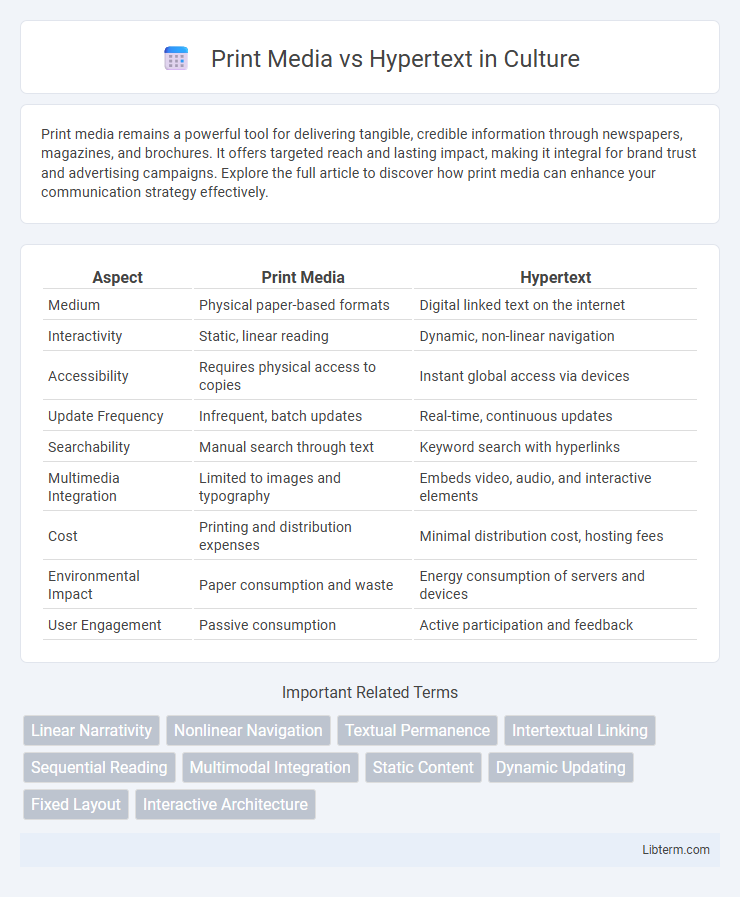Print media remains a powerful tool for delivering tangible, credible information through newspapers, magazines, and brochures. It offers targeted reach and lasting impact, making it integral for brand trust and advertising campaigns. Explore the full article to discover how print media can enhance your communication strategy effectively.
Table of Comparison
| Aspect | Print Media | Hypertext |
|---|---|---|
| Medium | Physical paper-based formats | Digital linked text on the internet |
| Interactivity | Static, linear reading | Dynamic, non-linear navigation |
| Accessibility | Requires physical access to copies | Instant global access via devices |
| Update Frequency | Infrequent, batch updates | Real-time, continuous updates |
| Searchability | Manual search through text | Keyword search with hyperlinks |
| Multimedia Integration | Limited to images and typography | Embeds video, audio, and interactive elements |
| Cost | Printing and distribution expenses | Minimal distribution cost, hosting fees |
| Environmental Impact | Paper consumption and waste | Energy consumption of servers and devices |
| User Engagement | Passive consumption | Active participation and feedback |
Introduction to Print Media and Hypertext
Print media, encompassing newspapers, magazines, and books, relies on static, linear text and imagery to deliver information, offering a tactile and tangible reading experience. Hypertext revolutionizes this format by enabling non-linear navigation through digital links, allowing users to interact with interconnected content dynamically across devices. The transition from print to hypertext enhances accessibility, user engagement, and information retrieval through multimedia integration and real-time updates.
Historical Evolution of Information Dissemination
Print media revolutionized information dissemination by enabling mass production of books, newspapers, and magazines after Gutenberg's 15th-century printing press invention, drastically expanding literacy and public knowledge. Hypertext emerged in the late 20th century with Tim Berners-Lee's development of the World Wide Web, allowing nonlinear access to interconnected digital content, transforming information retrieval and user interaction. This evolution from print-focused linear narratives to networked hypertext systems marks a pivotal shift in how societies consume, share, and engage with information.
Structure and Format: Linear vs Nonlinear
Print media employs a linear structure where information is presented sequentially, guiding readers through a fixed progression of text and images. Hypertext utilizes a nonlinear format, allowing users to navigate through interconnected nodes of information via hyperlinks, enabling dynamic and personalized pathways. This fundamental difference in structure and format influences user engagement and information retrieval efficiency.
Accessibility and Distribution Methods
Print media offers physical accessibility but can be limited by geographic distribution, delivery times, and costs, whereas hypertext provides instant global access via the internet, enabling dynamic content updates and interactive navigation. Digital hypertext eliminates barriers related to physical disabilities through screen readers, adjustable fonts, and multimedia integration, enhancing usability beyond static print formats. Distribution methods for print rely on physical logistics like printing presses and postal services, while hypertext leverages web servers, cloud platforms, and broadband connectivity for immediate and widespread dissemination.
Reader Engagement and Interactivity
Print media offers a tactile experience with fixed layouts that enhance focused reading but limits interactivity and real-time feedback. Hypertext enables dynamic content navigation through hyperlinks, multimedia integration, and user participation, significantly boosting reader engagement. Studies show interactive digital texts increase comprehension and retention by allowing personalized exploration and immediate access to related information.
Content Depth and Navigation Experience
Print media offers in-depth, linear content that allows readers to engage with comprehensive narratives or detailed information without distractions. Hypertext enhances navigation experience by enabling non-linear access to interconnected content through hyperlinks, facilitating quick jumps to related topics but often at the cost of depth. The contrast lies in print's structured depth versus hypertext's dynamic navigation, influencing how users consume and interact with information.
Preservation and Longevity of Information
Print media offers superior preservation and longevity of information due to its physical durability and resistance to technological obsolescence, with many printed documents lasting centuries under proper archival conditions. Hypertext relies on digital storage and formats that are vulnerable to hardware failures, software updates, and data degradation, posing significant challenges for long-term accessibility. Effective preservation of hypertext requires continuous migration and backup strategies to maintain information integrity over time.
Credibility and Editorial Standards
Print media maintains high credibility through rigorous editorial standards, including fact-checking, source verification, and professional journalism ethics. Hypertext platforms often lack standardized editorial oversight, which can lead to variable content quality and challenges in verifying information authenticity. Consequently, print media is generally perceived as more reliable for accurate and trustworthy information compared to hypertext-based sources.
Impact on Learning and Cognitive Processing
Print media offers a linear, fixed format that supports deep reading and enhances memory retention through sustained attention and reduced cognitive load. Hypertext presents non-linear, interactive content enabling quick access to multiple information nodes, which can improve navigation skills but may increase cognitive overload and distract from deep comprehension. Studies indicate print media fosters better information synthesis and critical thinking, while hypertext enhances exploratory learning and immediate information retrieval.
Future Trends in Media Consumption
The future of media consumption increasingly favors hypertext as advancements in digital technology enable interactive, personalized content experiences that print media cannot replicate. Hypertext facilitates instant access to vast information networks, embedding multimedia elements and real-time updates that align with the growing demand for dynamic and engaging content formats. While print media sustains niche markets, trends indicate a persistent shift towards digital platforms, driven by mobile device proliferation and AI-enhanced content delivery systems.
Print Media Infographic

 libterm.com
libterm.com